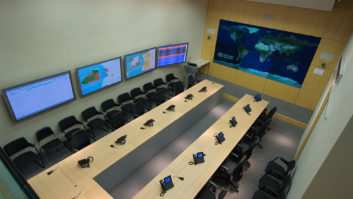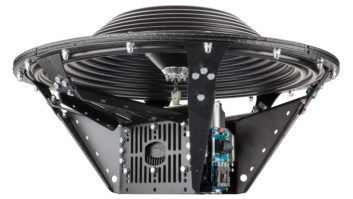
Having covered networked and multipoint-to-multipoint solutions, the final part of this signal management feature looks at future configurations.
As with any technology, then, the best and most appropriate choice is determined by the application – a point made clearly by David Jones, international sales manager at Lightware.
“Both technologies have their place in our industry and both have their drawbacks,” he asserts. “For example, standard routing and extension architectures are often found in very round numbers – 16 x 16, 32 x 32 for example – whereas most of the streaming devices can be sent through a standard network switch to create application specific sizes such as 3 x 59, 13 x 2 and so on. This is a clear advantage of needing less hardware and therefore potentially less cost with an IP-based solution.”
“Conversely,” he goes on, “the uncompressed and real-time transmission provided by the physical point-to-point solutions means no loss of signal quality and, with a Lightware system for example, zero frame delay whether routing, extending or both. Applications in the defence or military market or those where frame delay is simply unacceptable, such as rental or live events, are unlikely to be replaced, even in the mid- to longer term.”
“Let’s also not forget that, for whatever reason, IP-based video transmission is usually a step or two behind the data-rate requirements of the latest AV signals,” adds Jones. “For example, 10Gb Ethernet is now becoming a standard, whereas DP1.2 and HDMI 2.0 require double the throughput. Whether that trend will continue is anybody’s guess – but there are always applications requiring the latest technology and the highest bandwidth, and at the moment, point-to-point transmission tends to be the best way to guarantee this.”
Stijn Ooms, EMEA product manager at Crestron, agrees: “Choosing between these technologies is about making trade-offs between bandwidth, quality and latency. New streaming technologies help soften these choices, but at the same time, resolutions are constantly increasing and there is increasing talk of additional colour depth and dynamic range – all of which adds even more bandwidth demand to the equation. So long as there is demand for high-quality, low-latency video there will continue to be a market for point-to-point video distribution products. The beauty of a product like Crestron DigitalMedia is that it lets you specify between streaming and point-to-point on an input-by-input and output-by-output basis, rather than for an entire installation all at once.”
Today, then, the two approaches – point-to-point and networking – happily co-exist, each bringing application-specific benefits. But surely, eventually, the irresistible force of IP networks will prove – well, irresistible?
“The performance of both point-to-point and networking technologies will increase, but I can’t see the dynamic between the two changing,” responds Andy Fliss, director of marketing at TV One. “Point-to-point transmissions are likely to be enhanced by the accelerating adoption of fibre optics – with its exceptional bandwidth and potentially very long range. On the networking side, within five years we should see full implementations of H.265 compression and high-performance codecs to manage the data. We will also have access to AVB technology, which will help to manage network traffic for optimising AV.”
Brian Davies, AMX European technical director, doesn’t entirely agree. “Almost all technologies become less relevant over time and HDBaseT is no exception,” he answers. “Right now, all technology roads appear to lead to more and more solutions leveraging Ethernet as a common data transfer tool – but who knows if this will remain the truth in the future given the speed of technological change and the continual appetite for more bandwidth? It’s likely that the next leap in video distribution technology will be driven by technology advances in the consumer space being leveraged by manufacturers to provide professional solutions, as has been the case with HDMI.”
Thomas Tang, president of Apantac, however, sees something of an issue with HDMI source devices. “As far as I know, there is no off-the-shelf ASIC for networking products,” he says. “Once an ASIC is available, then we will start to see the landscape shifting. However, there is a large enough installed base currently and several major display manufacturers have adopted HDBaseT technology. With all of the non-conforming HDMI source devices on the market, HDBaseT has done a very good job of handling the spectrum of quality that is out there.”
More innovation
“Gefen has always been a huge supporter of HDBaseT,” smiles Tony Dowzall, president of Gefen, “especially with its ability to extend uncompressed high-quality audio and video over large distances. We think we will continue to see more innovation in this technology which will ensure its relevance and usage in the integrator’s toolkit.”
Fliss, however, is less convinced. “HDBaseT will determine its own destiny,” he says. “Through HDBaseT, the market has been trained to accept mediocrity for the sake of being able to handle proprietary HDCP encryption. Everyone has become accustomed to digital noise and inconsistent signals. Its less-than-impressive performance makes networked AV more acceptable and has given networking a better chance of taking over.”
The last word goes to Lightware’s Jones. “I don’t see a great difference in the next three years,” he discloses. “People have been talking about the convergence of AV and IT for a long time now and, assuming they were to converge, we would expect streaming technologies to take over. What we have found over the past few years is that most IT managers wouldn’t allow AV to be on the same network as IT anyway. Given the large bandwidths required in encoding multiple streams of Full HD or higher, this is probably a good decision. So, if we assume that we are looking at two separate networks anyway, why not just run uncompressed where the bandwidth on day one is the same as on day 1,000 and will encounter no delay? As IP-based technologies become more mature and as the market develops, I would expect the balance to tip eventually – but certainly not in the next three to five years.”
There are those in the industry who believe that the days of point-to-point are numbered and that networking will, sooner rather than later, carry all before it. It seems, though, that that’s not the case, and that the legacy technology still has a significant part to play – although the HDBaseT Alliance’s role may be critical.
Almost half a century ago, all we had was the black magic of point-to-point. Despite the no less mystical charms of IP networks, point-to-point looks as if it will persist for some time. Who knew, back then, that we were inventing the future?
www.amx.com
www.apantac.com
www.gefen.com
www.hdbaset.org
www.tvone.com
www.crestron.eu
www.lightware.eu







